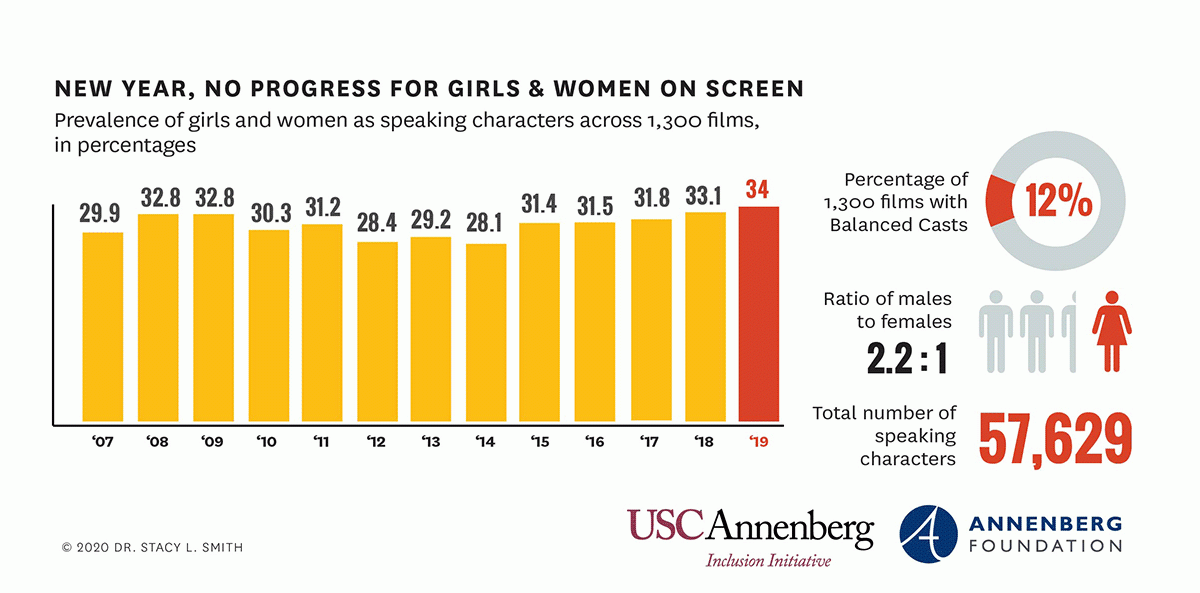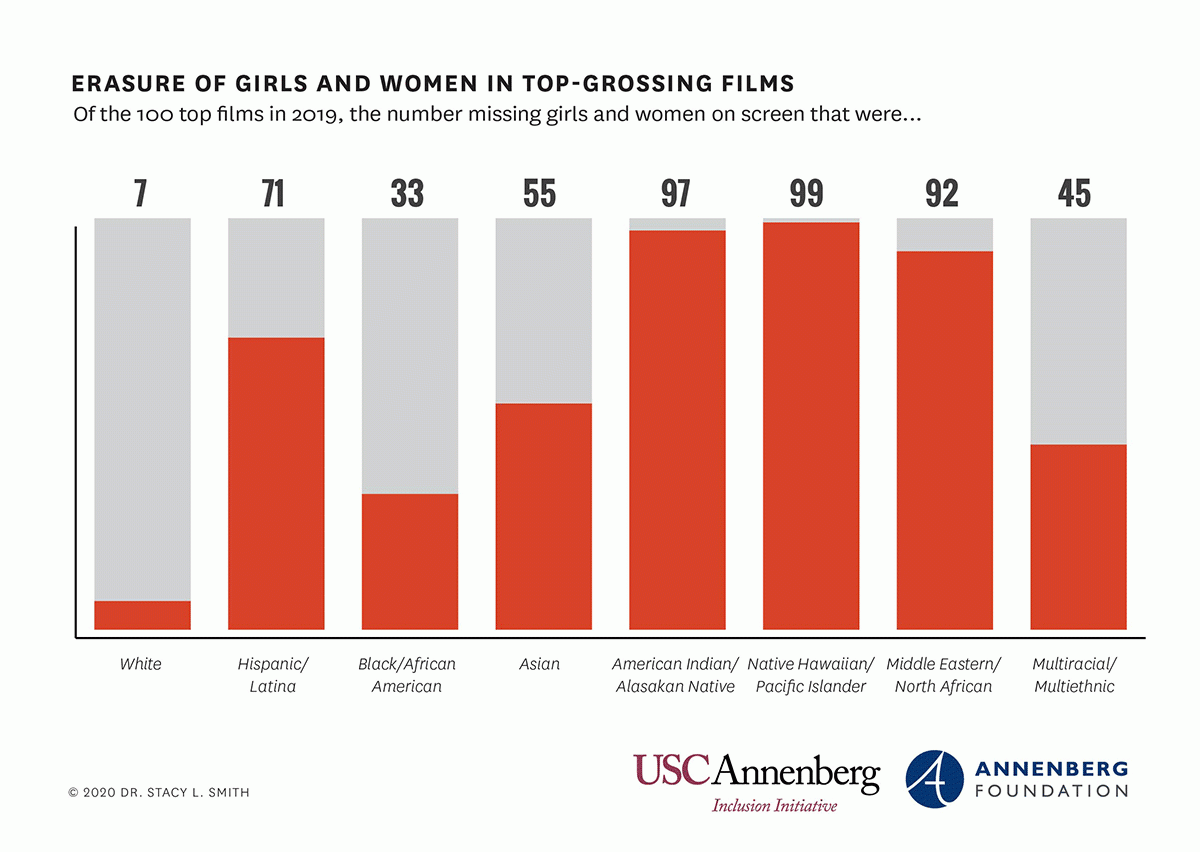In the midst of ongoing protests against racial injustice, a new study shows Hollywood movies perpetuate a lack of inclusive representation of those from underrepresented racial/ethnic groups, girls and women, the LGBTQ community, and individuals with disabilities.
The report, from Professor Stacy L. Smith and the Annenberg Inclusion Initiative at USC Annenberg, is the most comprehensive and intersectional look at film, having examined 57,629 characters in 1,300 top films from 2007 to 2019.

The study charts an increase in leading and/or co-leading characters from underrepresented racial/ethnic groups, from 27 films in 2018 to 32 films in 2019. Seventeen movies featured a girl or woman from an underrepresented group as a lead or co lead character in 2019 compared to just 11 in 2018, 4 in 2017 and 1 in 2007. Forty-three of 2019’s 100 top films had a girl or woman in a leading or co-leading role, a slight uptick from 39 in 2018 and a larger gain from 20 in 2007. However, only three films had a leading or co-leading role filled by a woman aged 45 or older, and only one of these roles went to a woman of color.
Despite the gains for protagonists, when it comes to all speaking characters, there has been little to no progress in 13 years. The percentage of female-identified speaking characters has not meaningfully increased since 2007, reaching only 34% in 2019. Similarly, 34.3% of speaking characters were from underrepresented groups, which is below the U.S. population and a slight decrease from 2018. The overall ecosystem of cinematic storytelling is still one in which girls, women and people of color are marginalized and minimized.

“After 13 years, it is not clear what might convince entertainment companies to change,” Smith said. “Despite public statements, the data reveal that there is still apathy and ambivalence to increasing representation of speaking characters overall in popular films. This is both the easiest representational gap to address and one that is essential to strengthen the pipeline to more prominent roles.”
Two other on-screen areas continue to fall behind population norms. The study found that of the 100 top films of 2019, just 2.3% of characters were shown with a disability, a number consistent over the last five years. A mere 1.4% of all characters in the top films of 2019 were from the LGBTQ community, despite a numerical increase over the past two years. Across 600 films from 2014 to 2019, only four characters were transgender. All of these characters were inconsequential to the plot and appeared on screen for only two minutes in total. Across 600 films and hundreds of hours of storytelling, transgender characters appear on screen for roughly the runtime of a film trailer.

The report also provides an “invisibility analysis” to determine how many movies were missing girls and women speaking characters on screen from different underrepresented groups. Across the 100 top films of 2019, the researchers found that 33 films were missing Black/African American girls and women on screen, 55 were missing Asian or Asian American girls or women, 71 were missing Hispanic/Latinas, and 45 were missing girls or women from Multiracial/Multiethnic backgrounds. Girls and women from other groups were also excluded, including American Indian/Alaskan Native characters (97 movies), Native Hawaiian/Pacific Islander characters (99 movies), and Middle Eastern/North African characters (92 movies). Further, 77 films did not portray a single girl or woman with a disability and 94 films were devoid of even one female-identified LGBTQ character.
“The erasure of girls and women from underrepresented racial/ethnic groups, the LGBTQ community, and those with disabilities remains a hallmark of top-performing Hollywood films,” Smith said. “Intersectional inclusion on screen must be an area for targeted intervention.”
The report also assessed inclusion behind the camera. Across 1,447 directors over 13 years, 4.8% were women, though the number and percentage of women directors reached a high in 2019. However, there was little progress for underrepresented directors — across 13 years, 6.1% of directors were Black, 3.3% were Asian, and 3.7% were Hispanic/Latino. Only in 2018 was any significant change observed; the percentage of Black directors increased meaningfully, then reverted to 2017 levels across the top films of 2019. Another area resistant to change? Only 13 women of color have directed a top film across 1,300 movies and 13 years.
“In contrast to our findings on top-grossing films, 20.7% of Netflix directors of U.S. based films in 2019 were women,” Smith said. “The legacy studios may want to take a note out of the streaming giant’s playbook on how to hire more inclusively behind the camera.”
Other positions behind the scenes were also evaluated. Women writers increased in 2019, though there was no change for women producers. While a 13-year high for female composers was reached, this represented only six women (5.2% of composers). In contrast, 70.4% of casting directors were women in 2019, a decrease from 2018 (85.1%) and 2007 (86.1%). When the intersectional distribution of casting directors was considered, 15.6% of casting directors in 2019 were women of color, while 54.8% were white women. Slightly more than one-quarter (27.4%) were white men, and men of color comprised a mere 2.2% of 2019’s casting directors.
The report also considered how the legacy studios and mini-major distributors performed across each inclusion indicator. Universal Pictures and Paramount Pictures both led on six or 32% of the 19 indicators in the study. Warner Bros. Pictures fared best on three or 16% of the indicators, Sony Pictures outpaced other companies on 11% or two indicators, and 20th Century Fox and Lionsgate each achieved a higher percentage on one or 5% of the indicators compared with their counterparts. Walt Disney Studios did not lead on any inclusion indicators in 2019.
However, when global box office earnings were examined by studio, Disney’s female-centered films and stories driven by underrepresented leads/co leads were far and away the box office frontrunners. With more than $4 billion earned globally on stories featuring girls and women and an additional $2.7 billion for stories with underrepresented leads/co leads, Disney outpaced other studios by a significant amount. Universal earned $896 million on its nine female-driven stories, and $1.6 billion for its eight films starring underrepresented leads/co leads. While the studios still have room to improve on inclusion overall, it is clear that an economic incentive may be one reason to do so, a conclusion supported by a research brief released earlier this year by the Annenberg Inclusion Initiative.
“This is a critical moment for the industry to commit to real and substantive change,” Smith said. “Too often the results of studies like this one garner attention without action. As protests for racial justice continue, it is imperative that companies move beyond performative statements and commit to take actions that will result in inclusive hiring practices on screen and behind the camera.”
